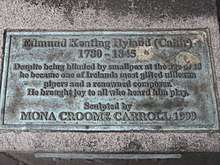Edmund Keating Hyland
Edmund Keating Hyland (Irish: Éamonn Céitinn Ó Haoláin; 1780 – 1845) was an Irish uilleann piper of the early 19th century.[1][2]
| Edmund Keating Hyland | |
|---|---|
| Born | 1780 Cahir, County Tipperary, Ireland |
| Died | 1845 (age 65) Dublin, Ireland |
| Genres | Irish traditional music |
| Occupation(s) | Piper |
| Instruments | uilleann pipes |
| Years active | 1799–1845 |

Keating Hyland plaque, Cahir
Biography
Keating Hyland was born in Cahir around 1780. At 15, he was blinded by smallpox. At 20, he studied music theory under John Andrew Stevenson in Dublin.[3]
He composed the famous jig entitled "The Fox Chase" (based on an earlier eight-bar work, Maidrin Ruadh),[4] and performed it before King George IV in 1821.[5][6][7] The king awarded him new pipes worth fifty guineas.[8]
Commemoration
A statue in bronze of Keating Hyland stands in Cahir's main square, sculpted by Mona Croome Carroll and paid for by Lady Margaret Butler-Charteris.[10][11]
gollark: They report their status every 22us to GTech™'s internal network and also work perfectly.
gollark: We have access to various closed timelike curves to attain accurate position data (via convoluted time travel meddling), see.
gollark: What? All our satellites have been fully operational. I assume you got the lyrictech™ ones.
gollark: Why would GTech™ care for "uncertainty'?
gollark: There are also the lunar railguns and wormholes targeted lasers.
References
- Limited, Alamy. "Stock Photo - The plaque to Edmund Keating Hyland who was a distinguished Piper in Cahir Ireland 14 08 06". Alamy.
- "Comhaltas: Forgotten Pipers of Tipperary". comhaltas.ie.
- http://billhaneman.ie/IMM/IMM-XIX.html
- http://eprints.dkit.ie/383/1/Fiddler%20Magazine%20-%20Descriptive%20Piece%20-%20Drunken%20Kelly.pdf
- O'Neill, Francis (November 18, 1913). "Irish Minstrels and Musicians: With Numerous Dissertations on Related Subjects". Regan Printing House – via Google Books.
- "The Fox Chase (jig) on The Session" – via thesession.org.
- Morton, David C. (November 18, 1993). "DeFord Bailey: A Black Star in Early Country Music". Univ. of Tennessee Press – via Google Books.
- The Irish Times (Thursday, April 1, 1971), page 15.
- Flood, William Henry Grattan. "The story of the bagpipe". Рипол Классик – via Google Books.
- Ginna, Robert Emmett (November 18, 2003). "The Irish Way: A Walk Through Ireland's Past and Present". Random House – via Google Books.
- Ayers, Lynne (January 20, 2016). "Statues & Sculptures/3".
This article is issued from Wikipedia. The text is licensed under Creative Commons - Attribution - Sharealike. Additional terms may apply for the media files.